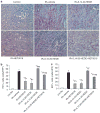Inhibition of 20-HETE synthesis and action protects the kidney from ischemia/reperfusion injury
- PMID: 20962739
- PMCID: PMC3813968
- DOI: 10.1038/ki.2010.377
Inhibition of 20-HETE synthesis and action protects the kidney from ischemia/reperfusion injury
Abstract
20-Hydroxyeicosatetraenoic acid (20-HETE) production is increased in ischemic kidney tissue and may contribute to ischemia/reperfusion (I/R) injury by mediating vasoconstriction and inflammation. To test this hypothesis, uninephrectomized male Lewis rats were exposed to warm ischemia following pretreatment with either an inhibitor of 20-HETE synthesis (HET0016), an antagonist (20-hydroxyeicosa-6(Z),15(Z)-dienoic acid), an agonist (20-hydroxyeicosa-5(Z),14(Z)-dienoic acid), or vehicle via the renal artery and the kidneys were examined 2 days after reperfusion. Pretreatment with either the inhibitor or the antagonist attenuated I/R-induced renal dysfunction as shown by improved creatinine clearance and decreased plasma urea levels, compared to controls. The inhibitor and antagonist also markedly reduced tubular lesion scores, inflammatory cell infiltration, and tubular epithelial cell apoptosis. Administering the antagonist accelerated the recovery of medullary perfusion, as well as renal medullary and cortical re-oxygenation, during the early reperfusion phase. In contrast, the agonist did not improve renal injury and reversed the beneficial effect of the inhibitor. Thus, 20-HETE generation and its action mediated kidney injury due to I/R. Whether or not these effects are clinically important will need to be tested in appropriate human studies.
Conflict of interest statement
All the authors declared no competing interests.
Figures






Comment in
-
20-HETE in acute kidney injury.Kidney Int. 2011 Jan;79(1):10-3. doi: 10.1038/ki.2010.396. Kidney Int. 2011. PMID: 21157458 Free PMC article.
References
-
- Lameire N, Van Biesen W, Vanholder R. Acute renal failure. Lancet. 2005;365:417–430. - PubMed
-
- Aydin Z, van Zonneveld AJ, de Fijter JW, et al. New horizons in prevention and treatment of ischaemic injury to kidney transplants. Nephrol Dial Transplant. 2007;22:342–346. - PubMed
-
- Karkouti K, Wijeysundera DN, Yau TM, et al. Acute kidney injury after cardiac surgery: focus on modifiable risk factors. Circulation. 2009;119:495–502. - PubMed
-
- Sutton TA, Fisher CJ, Molitoris BA. Microvascular endothelial injury and dysfunction during ischemic acute renal failure. Kidney Int. 2002;62:1539–1549. - PubMed
-
- Bonventre JV, Zuk A. Ischemic acute renal failure: an inflammatory disease? Kidney Int. 2004;66:480–485. - PubMed
Publication types
MeSH terms
Substances
Grants and funding
LinkOut - more resources
Full Text Sources
Other Literature Sources

